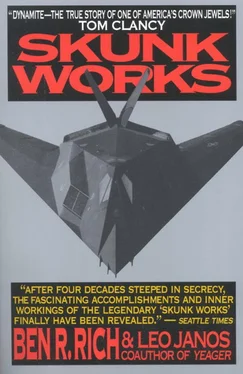I was not too surprised. The Skunk Works had firsthand experience with the latest Soviet equipment because the CIA had scored spectacular covert successes in acquiring their hardware by one means or another. We could not only test their latest fighters or new radars or missile systems, but actually fly against them. Skunk Works technicians pulled these systems apart, then put them back together, and made tools and spare parts to keep the Russian equipment serviced during testing, so we had a sound notion of what we were up against.
Still, the Air Force had no real interest in using the stealth option to neutralize Soviet defenses. The reason was that while we had learned over the years how to make an airplane less observable to enemy radar, the conventional Pentagon view was that the effectiveness of enemy radar had leaped far ahead of our ability to thwart it. The smart money in aerospace was betting scarce development funds on building airplanes that could avoid the Soviet radar net by coming in just over the treetops, like the new B-1 bomber ordered from Rockwell by the Strategic Air Command, whose purpose was to sneak past ground defenses and deliver a nuclear weapon deep inside the Soviet motherland.
That Pentagon briefing was particularly sobering because it was one of those rare times when our side admitted to a potentially serious gap that tipped the balances against us. I had our advanced planning people noodling all kinds of fantasies—pilotless, remote-controlled drone tactical bombers and hypersonic aircraft that would blister past Soviet radar defenses at better than five times the speed of sound once we solved awesomely difficult technologies. I wish I could claim to have had a sudden two a.m. revelation that made me bolt upright in bed and shout “Eureka!” But most of my dreams involved being chased through a maze of blind alleys by a horde of hostile accountants wielding axes and pitchforks.
The truth is that an exceptional thirty-six-year-old Skunk Works mathematician and radar specialist named Denys Overholser decided to drop by my office one April afternoon and presented me with the Rosetta Stone breakthrough for stealth technology.
The gift he handed to me over a cup of decaf instant coffee would make an attack airplane so difficult to detect that it would be invulnerable against the most advanced radar systems yet invented, and survivable even against the most heavily defended targets in the world.
Denys had discovered this nugget deep inside a long, dense technical paper on radar written by one of Russia’s leading experts and published in Moscow nine years earlier. That paper was a sleeper in more ways than one: called “Method of Edge Waves in the Physical Theory of Diffraction,” it had only recently been translated by the Air Force Foreign Technology Division from the original Russian language. The author was Pyotr Ufimtsev, chief scientist at the Moscow Institute of Radio Engineering. As Denys admitted, the paper was so obtuse and impenetrable that only a nerd’s nerd would have waded through it all— underlining yet! The nuggets Denys unearthed were found near the end of its forty pages. As he explained it, Ufimtsev had revisited a century-old set of formulas derived by Scottish physicist James Clerk Maxwell and later refined by the German electromagnetics expert Arnold Johannes Sommerfeld. These calculations predicted the manner in which a given geometric configuration would reflect electromagnetic radiation. Ufimtsev had taken this early work a step further.
“Ben, this guy has shown us how to accurately calculate radar cross sections across the surface of the wing and at the edge of the wing and put together these two calculations for an accurate total.”
Denys saw my blank stare. Radar cross section calculations were a branch of medieval alchemy as far as the non-initiated were concerned. Making big objects appear tiny on a radar screen was probably the most complicated, frustrating, and difficult part of modern warplane designing. A radar beam is an electromagnetic field, and the amount of energy reflected back from the target determines its visibility on radar. For example, our B-52, the mainstay long-range bomber of the Strategic Air Command for more than a generation, was the equivalent of a flying dairy barn when viewed from the side on radar. Our F-15 tactical fighter was as big as a two-story Cape Cod house with a carport. It was questionable whether the F-15 or the newer B-70 bomber would be able to survive the ever-improving Soviet defensive net. The F-111 tactical fighter-bomber, using terrain-following radar to fly close to the deck and “hide” in ground clutter, wouldn’t survive either. Operating mostly at night, the airplane’s radar kept it from hitting mountains, but as we discovered in Vietnam, it also acted like a four-alarm siren to enemy defenses that picked up the F-111 radar from two hundred miles away. We desperately needed new answers, and Ufimtsev had provided us with an “industrial-strength” theory that now made it possible to accurately calculate the lowest possible radar cross section and achieve levels of stealthiness never before imagined.
“Ufimtsev has shown us how to create computer software to accurately calculate the radar cross section of a given configuration, as long as it’s in two dimensions,” Denys told me. “We can break down an airplane into thousands of flat triangular shapes, add up their individual radar signatures, and get a precise total of the radar cross section.”
Why only two dimensions and why only flat plates? Simply because, as Denys later noted, it was 1975 and computers weren’t yet sufficiently powerful in storage and memory capacity to allow for three-dimensional designs, or rounded shapes, which demanded enormous numbers of additional calculations. The new generation of supercomputers, which can compute a billion bits of information in a second, is the reason why the B-2 bomber, with its rounded surfaces, was designed entirely by computer computations.
Denys’s idea was to compute the radar cross section of an airplane by dividing it into a series of flat triangles. Each triangle had three separate points and required individual calculations for each point by utilizing Ufimtsev’s calculations. The result we called “faceting”—creating a three-dimensional airplane design out of a collection of flat sheets or panels, similar to cutting a diamond into sharp-edged slices.
As his boss, I had to show Denys Overholser that I was at least as intellectual and theoretical as Ufimtsev, [1] Dr. Ufimtsev came to teach electromagnetic theory at UCLA in 1990. Until his arrival here he had remained blissfully unaware of his enormous impact on America’s stealth airplane development, but clearly wasn’t surprised by the news. “Senior Soviet designers were absolutely uninterested in my theories,” he wryly observed.
so I strummed on my desk importantly and said, “If I understand you, the shape of the airplane would not be too different from the airplane gliders we folded from looseleaf paper and sailed around the classroom behind the teacher’s back.”
Denys awarded me a “C+” for that try.
The Skunk Works would be the first to try to design an airplane composed entirely of flat, angular surfaces. I tried not to anticipate what some of our crusty old aerodynamicists might say. Denys thought he would need six months to create his computer software based on Ufimtsev’s formula. I gave him three months. We code-named the program Echo I. Denys and his old mentor, Bill Schroeder, who had come out of retirement in his eighties to help him after serving as our peerless mathematician and radar specialist for many years, delivered the goods in only five weeks. The game plan was for Denys to design the optimum low observable shape on his computer, then we’d build the model he designed and test his calculations on a radar range.
Читать дальше












